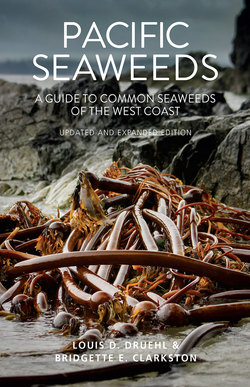Читать книгу Pacific Seaweeds - Louis Druehl - Страница 65
На сайте Литреса книга снята с продажи.
ОглавлениеGreen Seaweeds | 65
Identifying Pacific Seaweeds
the field. Kornmannia blades remain small (to 5 cm/2 in) and are typically found growing on seagrasses and other seaweeds, with K. leptoderma smaller than Ulvaria and Monostroma, and not turning dark upon drying. A definitive field identification of Monostroma is beyond the reach of mere mortals.
Dopamine, an adrenaline-like compound, is another exotic chemical found in Ulvaria. Could this sea lettuce give a person an adrenaline rush?
Our understanding of the relationships among these local bladed forms is largely the result of the efforts of Maurice Dube (Western Washington University). Dube had a green (seaweed) thumb and cultured these plants through their young, informative stages. He died suddenly when accident-ally struck by a cyclist. The following poem was read at the Fourth North-west Algal Symposium, March 1989, in his memory.
Maurice Dube you accidentally died in your sixtieth year,
While walking a darkened street near your home.
In that very special early morning light,
With a tea-quickened pulse and a little stiff,
You and your students greeted many a low tide,
Heralded by the forceful slap of waves.
A multitude of seaweed forms lie exposed,
Accessible to you and your students.
And a glimpse assures the essential presence of your
Rich green undulant Monostroma.
Maurice, when the pale, cold, waxing moon
Draws back the watery curtain of tide,
We will join you on those compelling shores,
And once again share the marine wonderment.
—Louis Druehl
Habitat & Distribution
Ulvaria is distributed from Alaska to northern California, and various Monos-troma species are distributed from Alaska to southern California. Kornman-nia grows attached to seagrasses and other seaweeds from Alaska to central California.
